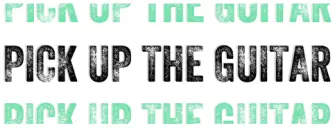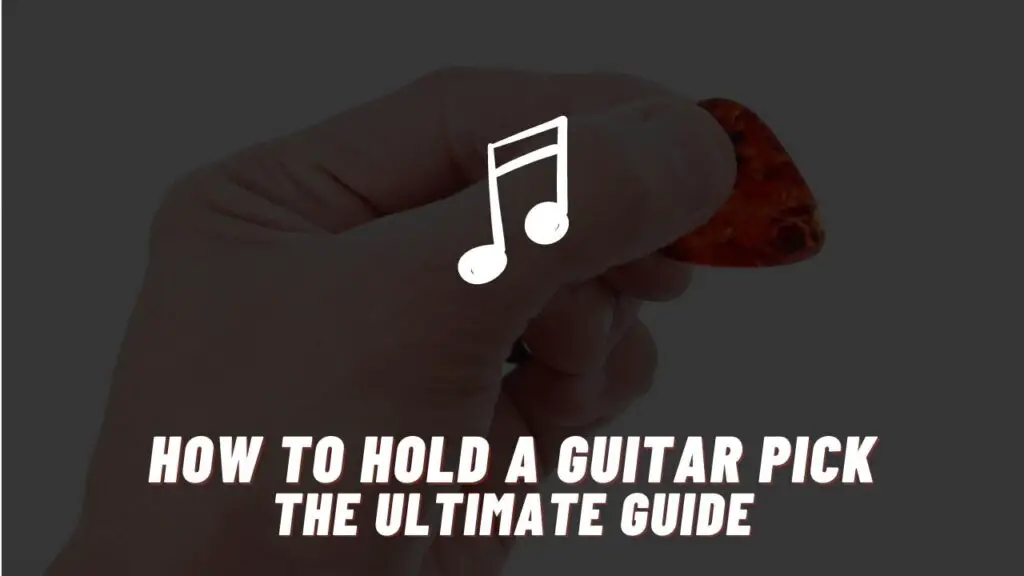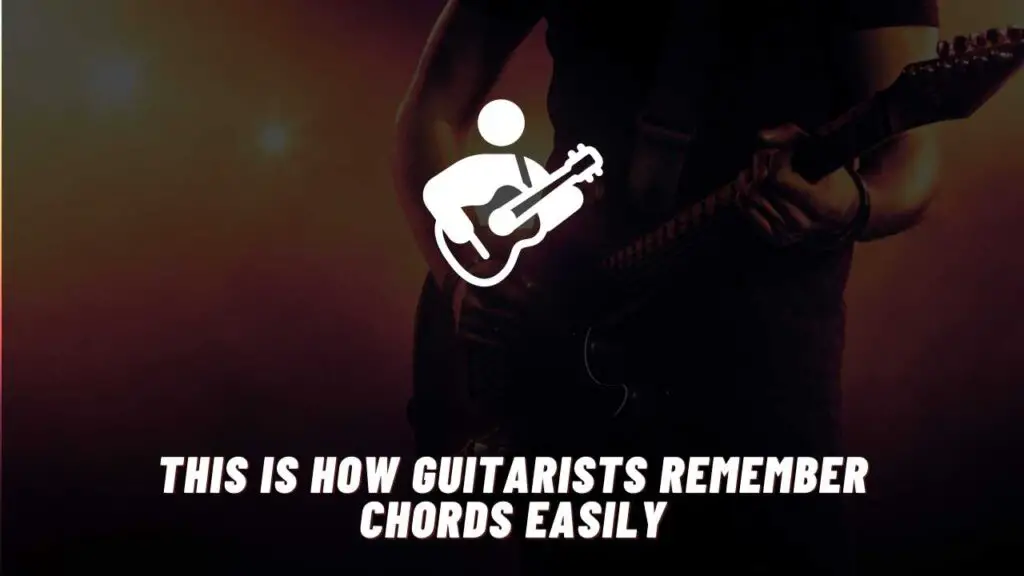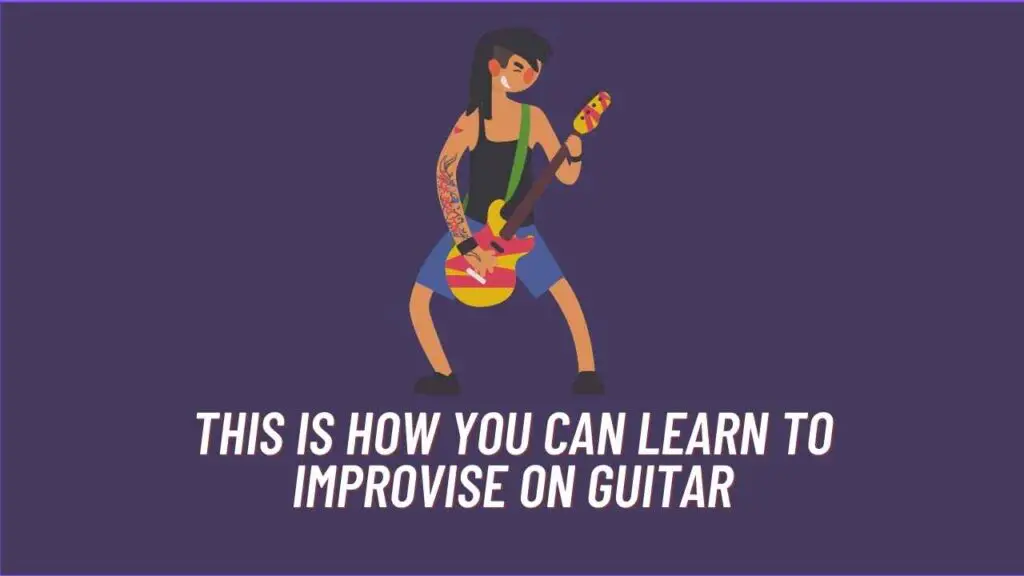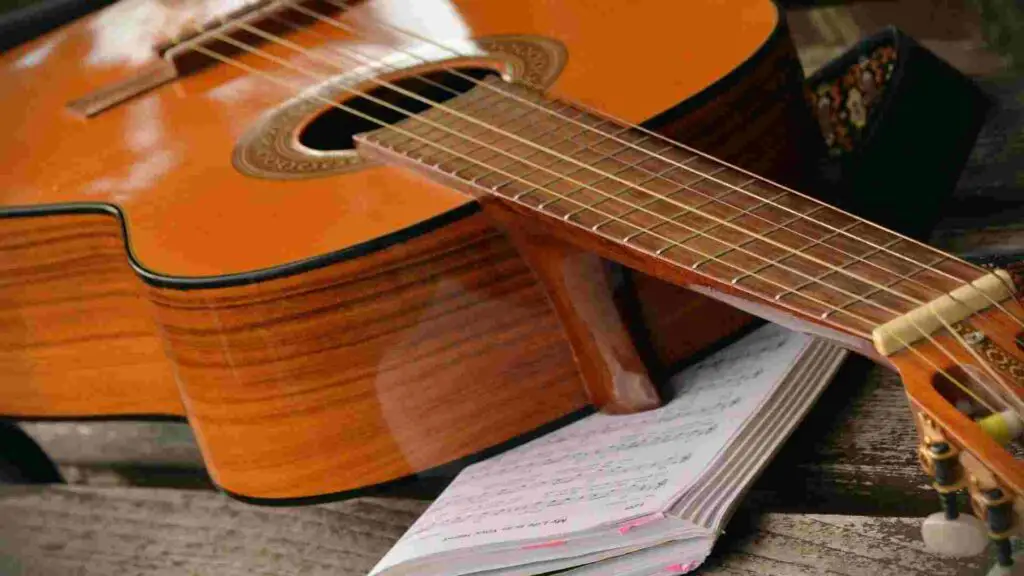Playing guitar without a pick (or plectrum) is a common approach. It involves a range of techniques that can be used to produce different sounds and styles. Playing without a pick is usually a stylistic choice, but for some players, it just feels more natural.
Perhaps you’re a beginner guitarist and you’re wondering whether to learn with a pick or fingers. Or perhaps you’ve been playing for years using a pick and now you’re looking to become a more versatile and well-rounded guitarist. Either way, this guide will help you understand everything you need to know about playing the guitar without a pick, so let’s dive in!
Can You Play Guitar Without a Pick?
Yes, you absolutely can play guitar without a pick! For many people, it’s the first way they learned how to play guitar, and for some, it’s the only way. The process involves using your thumb or fingers to pluck or strum the strings instead of using a pick.
Some genres of music are better suited to playing guitar with a pick, such as heavy metal. But you can play a wide range of styles using just your thumb and fingers. And even metal bands sometimes incorporate fingerpicking guitar into their songs – just check out the intro to ‘Nothing Else Matters’ by Metallica below! You can learn how to play ‘Nothing Else Matters’ here.
Can You Play Acoustic Guitar Without a Pick?
It’s extremely common to play acoustic guitar without a pick. In fact, some of the world’s most famous acoustic players and singer-songwriters play with their thumb and fingers, from Joni Mitchell to Ed Sheeran.
There are also whole styles and genres of acoustic guitar music that are played without a pick. Some examples are fingerstyle, classical, Spanish, and flamenco. We’ll talk more about fingerstyle guitar a bit later.
Many acoustic artists do play guitar with a pick. And some switch between pick and fingers, even within the same song, to produce a different sound and feel. Some examples of singer-songwriters who usually do play with a pick are Taylor Swift, Jack Johnson, and Jason Mraz.
Can You Play Electric Guitar Without a Pick?
When playing electric guitar with a clean tone, it’s very common to play without a pick. Your approach to fingerpicking a clean electric guitar should be similar to how you would play an acoustic guitar with your fingers. This is especially true when fingerpicking individual notes as opposed to strumming.
Fingerpicking electric guitar also has a similar feel to acoustic fingerpicking, as evidenced above with Metallica’s ‘Nothing Else Matters’. And once you’ve learned to play without a pick on either acoustic or electric guitar, you’ll be able to do so on the other with a bit of practice.
Strumming an electric guitar with your fingers or thumb is less common, as is fingerpicking with gain or distortion. For both of these sounds, using a pick is the more popular choice. Having said that, there are some very famous guitarists who play lead electric guitar without a pick. Some examples are Mark Knopfler, Jeff Beck, John Mayer, and Robbie Krieger. We’ll discuss these guitar heroes a bit later.
Is it Easier to Play Guitar with a Pick or Fingers?
The answer to whether it’s easier to play guitar with a pick or your fingers is… it depends. In my experience as a guitar player and teacher, beginner guitarists are usually able to learn to strum with their fingers or thumb quicker than with a pick. Learning to strum cleanly and evenly with a pick requires a delicate yet firm grip and a relaxed, accurate motion. Learning to strum with your fingers or thumb also requires a relaxed, accurate motion, but it tends to be slightly more forgiving if you hit the strings in the wrong way.
When it comes to playing individual notes with a pick or fingers – like for arpeggios, riffs, picking lines or solos – it’s difficult to say which is easier. Both require a fairly steep learning curve. You’ll need to build accuracy and control, whether that’s of your pick or of your fingers and thumb.
Learning fingerpicking or fingerstyle, for example, requires a great deal of coordination. You’ll often need to use multiple fingers and your thumb either in quick succession or at the same time. It also requires finger dexterity and strength. Learning picking patterns or lead lines with a pick, however, requires accuracy to hit the right string in the right way. It also requires coordination to hold and manipulate the pick, and general hand and wrist strength. This is especially true for fast picking lines.
As with any guitar technique, the trick is to start very slowly. You can then gradually increase your speed as you become more familiar with the movements. We’ll give you some exercises for playing guitar without a pick a bit later.
Should I Play Guitar with a Pick or Fingers?
I often hear beginner guitarists asking ‘Is it better to play the guitar with a pick or fingers?’. Even some experienced guitarists wonder whether they need to learn both. First of all, neither way is better than the other. Playing with a pick or with your fingers and thumb are both equally valid and popular ways of playing the guitar. Each approach serves a different purpose and produces a specific sound and feel. So, whether you should play guitar with a pick or fingers is a matter of personal preference. It also partly depends on the style of music you want to play.
Using a pick is a popular choice for playing many styles of music, such as rock, pop, and country. Picks can produce a bright, clear tone with a sharp attack. This can be useful for playing faster passages or producing percussive strumming sounds. In disco and funk guitar, for example, playing percussive scrapes by strumming muted strings is a crucial rhythmic element. If you try playing a Nile Rodgers strumming pattern with your fingers or thumb, it just won’t have the same attack, groove, or percussive feel.
Only playing guitar with your fingers can make it harder to play faster soloing lines (aka shredding). But there are ways you can ‘shred’ without using a pick, such as legato and tapping.
However, a pick isn’t always better. It’s trickier to play complicated picking lines with a pick or to pick more than one note at a time. So if you’re looking to learn complex picking lines, then mastering playing without a pick is essential. Plucking multiple notes at the same time also opens up the opportunity to play bass notes, melodies, and chords simultaneously. This is the bedrock of fingerstyle guitar. Playing with your fingers can produce a warmer and more natural sound that’s essential to many singer-songwriters and jazz guitarists.
It’s perfectly fine to either play guitar with a pick or without. However, if you want to be truly versatile, we recommend you learn both ways. It may take some practice to master both techniques, but being able to switch between them (or use both at the same time) will give you a wider range of tonal and stylistic possibilities, and more control over your instrument.
How to Strum a Guitar Without a Pick – Strumming Guitar with Fingers or Thumb
One of the most popular ways to play guitar without a pick is by strumming it. You’ll often see singer-songwriters and acoustic players using this technique. Strumming without a pick typically involves brushing your fingertips or the pads of your fingers across the strings, downwards and then upwards, in a rhythmic pattern. However, some guitarists use the side of their thumb. You may want to experiment with both ways to see which one feels more comfortable and sounds better to you.
Although we don’t suggest this when starting out, some guitarists alternate between fingers and thumb to create a different sound. Typically, they’ll play the downstroke using their index, middle, and ring fingers and the upstroke using their thumb. We recommend starting with either your fingers or your thumb to begin with. Below, we’ll be explaining how to strum a guitar with your fingers as this is the most common way.
4 Steps to Strumming a Guitar Without a Pick (With Your Fingers)
- Hold your strumming hand in a relaxed position with your fingers slightly curled and loose.
- Position your strumming hand above the strings over the sound hole of the guitar.
- For the downstroke, swing your hand down towards the guitar slightly using your wrist, and at the same time, let your fingers uncurl. Your fingers should gently make contact with the strings.
- For the upstroke, you do the opposite – bring your hand and wrist back up to the starting position and gently curl your fingers, brushing the strings as you do so.
We suggest you practice your downstrokes and upstrokes separately to start with. Then try putting them together (i.e a downstroke immediately followed by an upstroke).
Once you start getting the hang of downstrokes and upstrokes, try practicing different strumming patterns on a single chord. Then gradually increase the speed and complexity over time.
The aim when strumming the guitar is to make it as clean and fluid as possible. This involves building control over the strings you’re trying to play (and not play) and the attack, volume, and overall sound of the chord or note.
You may find at first that you hit the strings awkwardly, creating a dissonant or aggressive sound. Or you may find that some strings ring out louder than others, or strings that shouldn’t be ringing out do, and strings that should be ringing out don’t. But rest assured, all of these issues are perfectly normal when starting out. With enough practice, your finger strumming will soon sound clean, consistent, and controlled.
How to Solo on Electric Guitar Without a Pick – Playing Lead Guitar with Your Fingers
Although most famous guitar solos are played using a pick, that doesn’t mean you can’t play lead guitar without one. In fact, playing guitar solos without a pick can be extremely expressive. It allows you to achieve a punchy twang that’s difficult to replicate any other way. It also opens up the possibility of plucking or picking multiple notes at the same time, which can’t be done in quite the same way with a pick. You don’t need to just take my word for this by the way. Check out Jeff Beck’s ‘Hammerhead’ here, or John Mayer’s and Mark Knopfler’s soulful guitar solos below, all played without a pick!
John Mayer solos with and without a pick depending on the feel he’s trying to produce. In the video below, he jams a solo to ‘Slow Dancing In A Burning Room’. He starts with his fingers and then uses his pick to build the energy towards the end.
Mark Knopfler from Dire Straits is one of the most famous lead guitarists who doesn’t use a pick. He also happens to be one of the most tasteful guitarists as well! Check out his epic solo to ‘Sultans of Swing’ below.
Hopefully, you can now see that it’s not just possible to solo without a pick, it can sound amazing! Here are some tips to get you started:
5 Steps to Soloing on Guitar Without a Pick (With Your Fingers)
- Place the 1st finger of your fretting hand on the 5th fret of the low E string (6th string). Then pluck the string with the thumb on your picking hand multiple times.
- Do the same but this time pluck the string with the middle finger on your picking hand.
- Now hold the same note but try alternating the plucking between your thumb and middle finger.
- Then try playing up the string chromatically using each finger on your fretting hand (so 5th, 6th, 7th, 8th frets) and then back down again. Alternate the plucking between your thumb and middle finger.
- Once you’re comfortable, try playing up the chromatic scale (or a scale of your choice) using multiple strings. Again, alternate the plucking between your thumb and middle finger.
Depending on how proficient you are on the guitar already, you may need to work on each of these steps individually for some time before moving on to the next. Once you’ve started to build the coordination, timing, and strength to pick through scales with your thumb and finger, you can start to learn some simple licks and solos.
Fingerstyle Guitar – Playing Fingerstyle Without a Pick
Fingerstyle guitar is a technique of playing the guitar (usually acoustic guitar) using the fingers and thumb of the picking hand to play basslines, melodies, harmonies, and chords simultaneously. The thumb typically plays the bassline, leaving the index, middle, ring, and little fingers to play the melodies, harmonies, and chords.
Unlike other guitar techniques, such as strumming chords or playing riffs and picking lines, fingerstyle guitar is usually played entirely instrumentally and solo (without vocals or other instruments). In fact, the essence of fingerstyle is to accompany yourself, rather than a singer or other instrument, much like a solo pianist.
Fingerstyle guitar isn’t a style or genre of music in itself. Rather, it’s a guitar technique that can be used to play many different genres, including classical, folk, blues, and pop. It works beautifully at weddings or as background music, and it’s been popularized by many well-known guitarists, such as Chet Atkins, Tommy Emmanuel, and Andy McKee.
Below is an acoustic jam of ‘I’ll See You In My Dreams’ performed by Chet Atkins and Mark Knopfler. Both players demonstrate a fairly typical approach to fingerstyle guitar.
The song below is called ‘Drifting’ by Andy McKee, and this performance demonstrates a very different fingerstyle approach. Andy uses tapping, hammer-ons and pull-offs with both hands to produce his melodies. He then intersperses these with rich chords and percussive elements.
The fingerstyle technique is related to, and incorporates, fingerpicking. Fingerpicking involves playing the notes of a chord individually (rather than strumming them). It’s used in many styles of music, often when accompanying a vocalist or playing in a band. Fingerstyle uses fingerpicking and strumming techniques to create intricate and complex arrangements of songs on the guitar alone.
Overall, fingerstyle guitar is a versatile and expressive technique that can create a variety of sounds and textures. It can also be extremely impressive to watch and listen to. That being said, the high level of skill demonstrated by some fingerstyle guitar players shouldn’t deter you from learning this technique. There are plenty of beginner fingerstyle exercises and courses available, and with a bit of practice, you should soon be able to play some slow and relaxing fingerstyle pieces.
4 Steps to Prepare to Learn Fingerstyle Guitar
- Get used to strumming the guitar on one chord with your fingers as explained earlier. Then practice moving through chord progressions.
- Get used to fingerpicking individual notes of chords, from the lowest note to the highest and back down again. This is called playing an arpeggio.
- Learn new strumming patterns, fingerpicking lines, and songs that use these techniques to hone your new skills.
- Sign up to a beginner’s fingerstyle course!
Guitar Tapping – Tapping on Guitar Without a Pick
Guitar tapping is a technique where you tap the fingers of your picking hand on the fretboard to sound the strings and then release them to produce a different note. The technique is closely related to hammer-ons and pull-offs. In fact, tapping is essentially a series of hammer-ons and pull-offs executed by both hands together (as opposed to just the fretting hand). It also produces a similar, legato sound but tends to be used for more complex lines that span greater distances on the fretboard.
Guitar tapping has been used in many genres of music, including blues, jazz, and most famously in rock and metal. The technique started to make an appearance in popular music in the 1960s. However, it wasn’t until 1977 that guitar tapping was catapulted into mainstream music with Eddie Van Halen’s epic ‘Eruption’ solo. Guitarists and non-guitarists alike were awe-struck by this ‘new’, lightning-fast sound. And it was as mesmerizing to watch as it was to listen to. Other virtuoso guitarists have since incorporated tapping into their own music, such as Steve Vai, Joe Satriani, and Paul Gilbert.
Guitar tapping can be a challenging technique to learn. It requires coordination, precision, finger strength, and calluses (hardened finger pads) on both hands. However, with enough practice, you’ll soon be able to play simple tapping lines, and eventually more complex ones. The great thing is, even simple tapping lines sound really impressive. And take it from me, it’s also one of the most fun techniques to play on the guitar!
5 Steps to Learn Guitar Tapping
- Place the 1st finger of your fretting hand on the 7th fret of the high E string (1st string).
- Tap (hammer-on) the middle finger of your picking hand onto the 12th fret of the same string so it makes a sound (while keeping the 1st finger of your fretting hand in position).
- Pull off the middle finger on your picking hand with a downward motion so the string rings out at the 7th fret (where your 1st finger is).
- Keeping your 1st finger in place, hammer on the little finger of your fretting hand onto the 10th fret of the same string as hard as possible.
- Tap the middle finger of your picking hand onto the 12th fret again, remove your little finger, and you’re ready to pull off and repeat the steps.
Practice the 5 steps above very slowly, focusing on making a clear sound with each tap, hammer-on and pull-off. Gradually increase the speed as you become more comfortable with the movements. When played fast, even this simple tapping line will sound awesome! If you’re struggling to make a sound when hammering on with your little finger, then you can use your ring finger instead. However, I recommend you build strength in your little finger as well if you want to learn advanced tapping lines.
Guitar Harmonics – Playing Harmonics on Guitar Without a Pick
Playing harmonics on the guitar is another technique where you don’t need a pick (although you can also play harmonics using a pick). The two types of harmonics where you don’t need a pick are called artificial harmonics and tapped harmonics.
Artificial harmonics are where you place a finger from your picking hand over a fret (over the metal fret itself, not the space in between) so it lightly touches the string, and then pluck the string with your thumb of the same hand.
Tapped harmonics are where you tap a string over a metal fret, usually with your picking hand. Both techniques produce a higher pitch than the note you’re actually touching, and the sound has a bell-like timbre to it.
These techniques are based on the principles of harmonics, which are natural overtones produced by a vibrating string. Harmonics are used to add a unique texture to solos, riffs or chord progressions. The movements require a great deal of finesse and timing, which can make these techniques frustrating to learn. But once you get the hang of them, they’ll open up a huge range of sonic possibilities in your guitar playing.
Hybrid Picking – Playing Guitar with Pick & Fingers
I mentioned earlier that if you have the time and patience, it may be useful to learn guitar with and without a pick. As a fitting end to the article, I thought it was worth mentioning a technique that combines both approaches.
Hybrid picking involves the use of both the pick (plectrum) and the fingers. You use the pick to play bass notes or to accentuate notes, and your middle, ring and little fingers to create melodic passages or rich harmonies by plucking or fingerpicking the other strings.
The technique allows guitarists to achieve a combination of picked and fingerpicked sounds. Combining the attack and clarity of picked notes with the warmth and nuance of fingerpicked notes. This results in a versatile and dynamic playing style. It can also increase control and dexterity, allowing guitarists to execute complex patterns and achieve a broader range of tonal possibilities.
Hybrid picking is used in various musical genres, including country, blues, rock, jazz, and fusion. Two guitarists that use the technique to great effect are Tom Quayle and Guthrie Govan.
Wrapping Up
Many guitarists decide to play guitar without a pick, either as an occasional stylistic choice or as a general approach. Playing guitar without a pick involves a range of techniques that produce different sounds and styles. Strumming, soloing, fingerpicking, fingerstyle, tapping, and harmonics can all be played without a pick. And hybrid picking is played using a combination of pick and fingers.
Whether you’re a beginner or an experienced player, practicing different fingerpicking and finger-strumming patterns can help you develop your skills and become a more versatile guitarist. Once you’re comfortable picking and strumming with your fingers, you may want to experiment with soloing, fingerstyle, tapping, harmonics, and hybrid picking to really take your playing to the next level. I hope you’ve found this guide valuable. And whether you decide to learn guitar with or without a pick, I wish you the greatest success!
